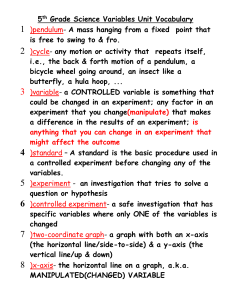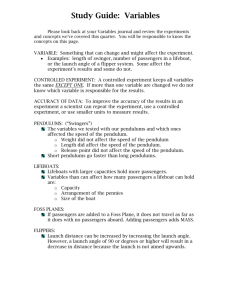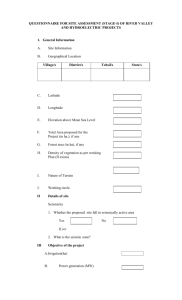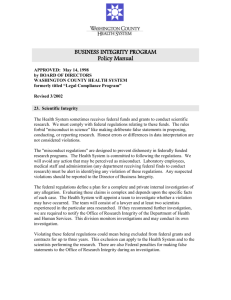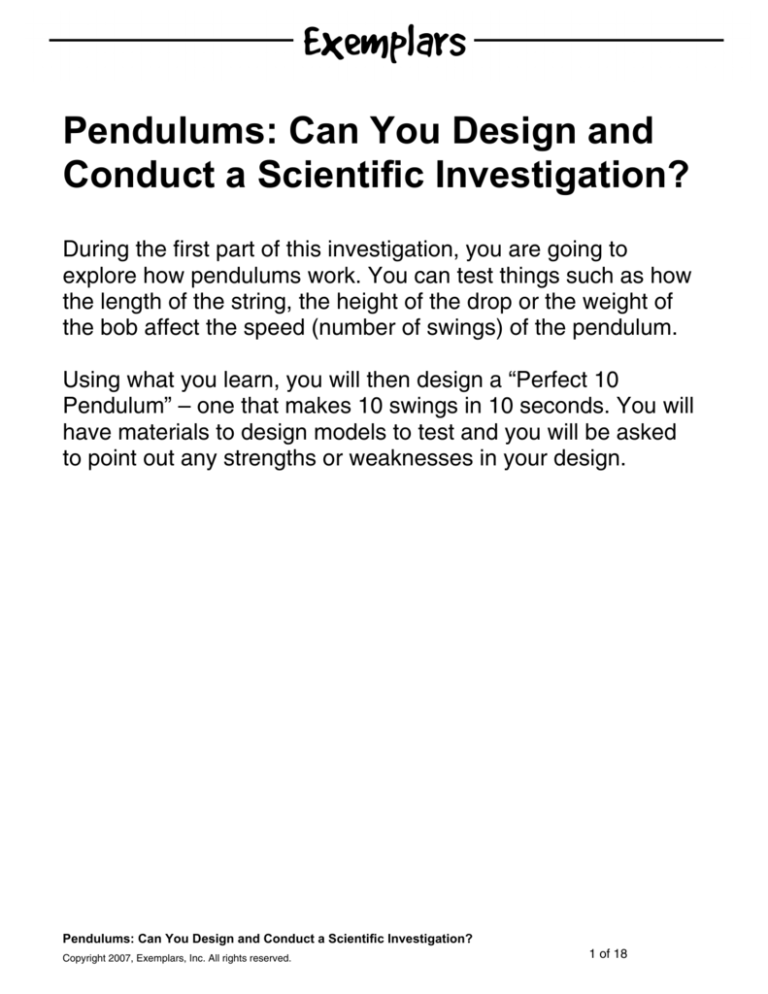
Pendulums: Can You Design and
Conduct a Scientific Investigation?
During the first part of this investigation, you are going to
explore how pendulums work. You can test things such as how
the length of the string, the height of the drop or the weight of
the bob affect the speed (number of swings) of the pendulum.
Using what you learn, you will then design a “Perfect 10
Pendulum” – one that makes 10 swings in 10 seconds. You will
have materials to design models to test and you will be asked
to point out any strengths or weaknesses in your design.
Pendulums: Can You Design and Conduct a Scientific Investigation?
Copyright 2007, Exemplars, Inc. All rights reserved.
1 of 18
Pendulums: Can You Design and Conduct a Scientific
Investigation?
Suggested Grade Span
6–8
Task
During the first part of this investigation, you are going to explore how pendulums work. You
can test things such as how the length of the string, the height of the drop or the weight of the
bob affect the speed (number of swings) of the pendulum.
Using what you learn, you will then design a “Perfect 10 Pendulum” – one that makes 10
swings in 10 seconds. You will have materials to design models to test and you will be asked to
point out any strengths or weaknesses in your design.
Big Ideas and Unifying Concepts
Cause and effect
Change and constancy
Models
Physical Science Concepts
Motion and forces
Properties of matter
Mathematics Concepts
Data collection, organization and analysis
Graphs, tables and representations
Measurement
Time Required for the Task
Two to three 40- to 50-minute periods. (Two sessions may be needed for the first exploration to
be completed. It is important that students be given ample time for each part of the inquiry.)
Context
Many commercially available science texts and activity kits have hands-on activities using
pendulums, and by the sixth grade, many students have probably already had some experience
Pendulums: Can You Design and Conduct a Scientific Investigation?
Copyright 2007, Exemplars, Inc. All rights reserved.
2 of 18
with them. Therefore, this assessment activity with pendulums can be easily used by uppergrade teachers to assess students’ ability to use the scientific method. (In other words, this
activity is more about assessing scientific investigation skills – the ability to control and test
variables one at a time – and less about assessing knowledge of pendulums at this point in the
teaching cycle.) This inquiry with pendulums is adapted from one of Piaget’s classic
experiments designed to probe the development of logico-deductive thinking in seven- to 15year-old children (Inhelder and Piaget, 1955).
The purpose of this preteaching assessment activity is to assess the inquiry knowledge and
skills that students already possess before the new teaching begins. Although no specific
preteaching occurred to prepare students for this assessment activity (as it would in a
culminating activity), this assessment makes it easy to see what skills of investigation students
have already mastered over the year(s). Then, the teacher can identify what new teaching,
reinforcement and practice should occur during future units of study.
Students work in pairs to design and conduct their investigations. Each individual student is
then responsible for completing an individual lab book stating the hypothesis, describing the
design, organizing the data collected and stating conclusions. This activity also stresses two
important aspects of cooperative learning: although students work together to design and
conduct the investigation (positive interdependence), each student has the individual
responsibility to articulate what s/he has learned from the activity (individual accountability).
What the Task Accomplishes
This investigation task is an excellent introduction to the scientific method and scientific inquiry.
It allows the teacher to assess scientific literacy – what knowledge and skills related to scientific
exploration students have already acquired. All aspects of the scientific method are included in
this activity: testing a hypothesis, designing an investigation and controlling variables, collecting
and recording data, organizing data into a graphic representation, analyzing data to draw
conclusions, and using data to challenge misconceptions and raise new questions. Because
there are several possible variables that could be tested, this activity allows the teacher to see
which students are able to understand the need to isolate variables and test them
independently. Additionally, this task emphasizes that mathematics and design are essential to
conducting scientific inquiry.
How the Student Will Investigate
Begin by assigning roles to cooperative, two-member teams: principal investigator/materials
manager and recorder/reporter. (See team worksheets.) For this activity, I combine four roles
into two, placing a higher accountability and engagement level on each individual student for
completing the inquiry task. After clarifying the information on the team worksheets, students
work in pairs to complete the task.
Students should be encouraged to first make some pendulums and explore how they work. A
“swing” is defined as the distance traveled in one direction. Demonstrate for students what a
swing looks like. (When the pendulum begins to swing back the other way, it is counted as a
Pendulums: Can You Design and Conduct a Scientific Investigation?
Copyright 2007, Exemplars, Inc. All rights reserved.
3 of 18
second swing.) Be sure that all students can make a pendulum, count the swings and keep
track of counting seconds during this initial exploratory session.
After about 20 minutes, discuss with students that they will be testing their predictions about
some of the variables that effect the number of swings. To prepare them for writing a testable
question/hypothesis, ask them to discuss whether they think that changing the weight of the
bob will change the number of swings in ten seconds. Also ask whether they think changing the
length of the string will change the number of swings in ten seconds. Ask whether there are
other variables that might affect the number of swings. (You may wish to write some of the
theories generated on the board.) Remind them to think about the things they have just done
with their pendulums.
Direct pairs of students to write a testable question and a plan for testing it. Remind them to
record all data and observations. (Students may need up to 30 minutes to complete this part of
the task.)
The design of the “Perfect 10 Pendulum” is the final part to this inquiry. Students should use
their data from the previous explorations to create a pendulum that makes 10 swings in 10
seconds. They should record all data and note any changes/modifications in their designs.
Questions for the lab report are listed in the Teaching Tips and Guiding Questions section.
A word about cooperative investigation groups: Begin by assigning roles and defining the
inquiry task with clearly stated outcomes. A general rule of thumb in planning an inquiry task for
cooperative groups is to determine the number of members in a group by the number of
necessary roles for completing the task. There is nothing worse than having too little for each
team member to do. I also structure the task so that a bit less time is given at the start than I
think the teams will need. This forces teams to immediately get organized for the task. Then, I
move about the room, checking on progress. We have a rule, “ask three before me,” which
translates to: Do not ask the teacher what you are supposed to be doing unless you have asked
three other students first. Usually the easier questions can be answered quickly this way,
keeping procedural questions to a minimum and maximizing use of teacher time for more
important interventions during the inquiry lesson. Materials can be stored in a central location in
the classroom or at each lab table, depending on your classroom setup. Generally, I prefer to
place the responsibility on students for gathering and returning the equipment they will need for
investigations, rather than using my time to prepare and count all materials they will need. (Of
course, there are exceptions – especially when special preparation of materials or potentially
hazardous materials are being used during investigations.)
Interdisciplinary Links and Extensions
General Extensions
Find examples of pendulums (such as swings on the playground) and try some new
investigations. Can you build a scale model of a much larger pendulum?
Try to design a “Perfect 6” or a “Perfect 5” pendulum. Can you write a general rule about the
relationship between the length of the string and the number of swings?
Pendulums: Can You Design and Conduct a Scientific Investigation?
Copyright 2007, Exemplars, Inc. All rights reserved.
4 of 18
Science
This activity could also be used as part of an end-of-year science portfolio assessment to
determine the skills related to the scientific method that students have acquired at this point in
their science education. Students could also be asked to review another student’s lab book and
assess whether or not the investigation could be repeated — using only the descriptions of the
experimental design and data provided in the lab book. Are the measurements of the lengths of
the strings included? Is it clear how many trials were conducted? Are units of measure labeled?
Is there a drawing to clarify the design? Since “real scientists” review their colleagues’ findings
using a similar critiquing process, it demonstrates to students that their work is valued in the
school’s scientific community.
Information Technology
Students with access to the Internet might want to publish the results of future scientific
investigations, inviting other students across the globe for critical response and verification of
their results. This expands the scientific community and might also invite professional scientists
to act as mentors to your students.
Teaching Tips and Guiding Questions
Teachers should move about the room observing and assisting/demonstrating when necessary,
during the early exploration activities. During the final part of the task, teachers should not
provide guidance other than the questions for the report.
Questions for the lab report could include:
•
•
•
•
•
•
•
•
What is your hypothesis (or prediction)? What is your testable question?
What is your plan for testing your hypothesis? What will you test?
What data did you collect? What did you observe? What did you modify?
What are your conclusions? What did you learn about the effects of changing the weight of
the bob or the length of the string?
Can you support your conclusions (give examples) using your data?
Were you able to design a Perfect 10 Pendulum? How did you go about it?
What have you learned about scientific investigation? about pendulums?
What do you still wonder about?
Concepts to be Assessed
(Unifying concepts/big ideas and science concepts to be assessed using the Science
Exemplars Rubric under the criterion: Science Concepts and Related Content)
Scientific Method: Students determine the patterns and/or which kinds of change are
happening by making a graph or table of measurements (change and constancy). Students
observe and explain reactions when variables are controlled (cause and effect). Students see
that how a model works after changes are made to it may suggest how the real thing would
work if the same thing were done to it, and that choosing a useful model (not too simple/not too
Pendulums: Can You Design and Conduct a Scientific Investigation?
Copyright 2007, Exemplars, Inc. All rights reserved.
5 of 18
complex) to explore concepts encourages insightful and creative thinking in science,
mathematics and engineering (models).
Physical Science – Properties of Matter: Students observe and compare objects.
Physical Science – Motion and Forces: Students observe that an unbalanced force acting on
an object changes its speed or path of motion or both.
Mathematics: Students use tables and graphs to show how values of one variable are related
(increase, decrease, etc.) to values of another. Students see that using numerical data and
precise measurements in describing events, answering questions, providing evidence for
scientific explanations and challenging misconceptions can be essential to scientific inquiry.
Skills to be Developed
(Science process skills to be assessed using the Science Exemplars Rubric under the criteria:
Scientific Procedures and Reasoning Strategies, and Scientific Communication Using Data)
Scientific Method: Observing, predicting/hypothesizing, designing an investigation, measuring,
controlling variables, collecting/recording data, organizing data into a graphic representation,
analyzing data to identify relationships and draw conclusions, communicating findings,
challenging misconceptions and raising new questions.
Other Science Standards and Concepts Addressed
Scientific Method: Students describe, predict, investigate and explain phenomena.
Scientific Theory: Students look for evidence that explains why things happen and modify
explanations when new observations are made.
Scientific Tools: Students use measuring devices (measuring tapes, timers) to gather data.
Physical Science – Properties of Matter: Students observe, describe and compare objects and
materials according to similarities and differences of their physical properties.
Physical Science – Motion and Forces: Students identify and describe an unbalanced force
acting on an object to change its speed or path of motion.
Suggested Materials
This activity requires little advanced preparation and minimal materials for the inquiry task to be
carried out successfully. Refer to the worksheets on pages 10 and 11.
Pendulums can be made using inexpensive metal washers of several (at least three) sizes,
paper clips and string cut to different lengths. (Some students used dental floss instead of string
for this task.) Rulers, tape measures or yardsticks are necessary for measuring the length of the
Pendulums: Can You Design and Conduct a Scientific Investigation?
Copyright 2007, Exemplars, Inc. All rights reserved.
6 of 18
strings. Masking tape, scissors and a timer (stopwatches or large wall clocks with visible
second hands) are also needed. Students should have notebooks (lab books) in which to
record data and draw their designs.
Students can swing pendulums freely or tape a pencil to the edge of a desk so that the
pendulum can hang from it and swing freely. Another possibility is to bend a coat hanger and
either tape it to a desk edge or close it in a desk or drawer so that the curved hook at the top of
the hanger acts as a hanger for the pendulum to swing from.
Possible Solutions
Students should be able to determine that the length of the string will affect the number of
swings. The weight of the bob will not affect the number of swings. (This is a very difficult
misconception to overcome for many students — even when the data refute it! See Practitioner
example for discussion of experimental error.)
Students’ solutions should demonstrate the following skills:
•
•
•
•
•
•
Stating a hypothesis (or testable question) as a cause-effect relationship
Designing an investigation and building a model to test the question
Controlling one variable at a time and indicating the number of trials
Using tools to measure and record data, with appropriate units of measure labeled
Using a graph or table to represent data
Using data as evidence and applying logic to support conclusions
Task-Specific Assessment Notes
Novice
This student has little understanding of the inquiry process and the importance of testing one
variable at a time. Both the length of the string and the weight of the bob are tested at the same
time in a “guess-and-check” process. The student participates in exploration but does not
record data in an organized manner. It appears that either only one trial was completed or only
data for one trial were recorded. Conclusions are not supported by data. The student does not
discuss procedures used.
What this Novice investigator needs next:
• Guided practice in collecting data for at least the first part of the investigation, until s/he
shows understanding of a clear purpose for what s/he is doing
• A chart to fill in which suggests the number of trials to perform while testing only one
variable
• Reminders along the way about what question s/he is testing, what data s/he is gathering,
why s/he needs to write or draw, etc.
• A short list of related science words (collaboratively built with a partner or teacher) that will
help him/her to talk about what s/he is doing (variable, data, length, etc.).
• Some clear models of what the Apprentice level looks like
Pendulums: Can You Design and Conduct a Scientific Investigation?
Copyright 2007, Exemplars, Inc. All rights reserved.
7 of 18
Apprentice
This student states an hypothesis as a cause-effect relationship and understands that during
inquiry and exploration some variables must remain constant. The plan for testing the (two)
hypotheses keeps the length of the string (long) constant with three different weights, then
again with a short length and three different weights. Although the student states two different
hypotheses, s/he only tests the effects of the weight. In the exploration, s/he uses appropriate
tools to gather data but lacks the skills to organize it into a chart for easier analysis. While the
student successfully completed the task of finding a Perfect 10 Pendulum, s/he never used data
to identify the pattern that the weight made no difference. The student did not measure and
record the length of the string, yet his/her conclusions refer to the effects of the length of the
string. S/he just may have been lucky in completing the task.
What this Apprentice investigator needs next:
• A checklist for seeing how the plan connects to the testing of each hypothesis and to
stated conclusions
• A reminder to measure and record such things as length of string so that someone else
can repeat his/her tests
• Assistance in creating a graphic organizer/chart to put his/her data in
• Assistance and demonstrations in looking for patterns in the data in the charts
• Clear models/descriptions of what the Practitioner level would look like
Practitioner
This student states two hypotheses as cause-effect relationships and understands that during
inquiry and exploration some variables must remain constant. The plans for testing the (two)
hypotheses are well-organized, and the reader can follow them through to each set of
conclusions. Variables are identified and tested separately in the investigation. Appropriate
tools are used to gather data for six trials. Data are recorded accurately. Conclusions are
clearly supported by data, yet the first conclusion is not accurate. The student recorded minimal
differences in the number of swings with different weights and interprets it as a cause-effect
relationship. (This is typical at this age and opens the door for new teaching opportunities.)
What this Practitioner investigator needs next:
• Guidance in assessing his/her progress with peers and for himself/herself
• Guidance in how to check the accuracy of his/her data and how to understand the concept
of experimental error (when errors are within reasonable expectations and do not indicate
significant results or changes). The student should complete more trials than three to begin
to see a definite pattern or the class could compile all of their data into one comprehensive
chart to look for trends.
• Examples of more complex ways to organize and represent data
• Clear models/descriptions of what the Expert level would look like
Pendulums: Can You Design and Conduct a Scientific Investigation?
Copyright 2007, Exemplars, Inc. All rights reserved.
8 of 18
Expert
This student states two hypotheses as cause-effect relationships and understands that during
inquiry and exploration some variables must remain constant. The plan for testing the (two)
hypotheses is not as well-organized as the Practitioner level but does discuss the general
procedures to be used. The reader can clearly see a connection between each hypothesis and
each conclusion.
•
•
•
•
Variables are identified and tested separately in the investigation
Appropriate tools are used to gather data for 12 trials
Data are recorded accurately and organized in a chart
Conclusions are clearly supported by data
What this Expert investigator needs next:
• Guidance in assessing his/her progress with peers and for himself/herself
• Guidance in how to check the accuracy of data and how to understand the concept of
experimental error (when errors are within reasonable expectations and do not indicate
significant results or changes)
• Examples of more complex or electronic ways to organize and represent data
• Clear models/descriptions of what other Expert level work looks like
Pendulums: Can You Design and Conduct a Scientific Investigation?
Copyright 2007, Exemplars, Inc. All rights reserved.
9 of 18
Pendulums: Can You Design and Conduct a Scientific Investigation?
Copyright 2007, Exemplars, Inc. All rights reserved.
10 of 18
Pendulums: Can You Design and Conduct a Scientific Investigation?
Copyright 2007, Exemplars, Inc. All rights reserved.
11 of 18
Novice
Pendulums: Can You Design and Conduct a Scientific Investigation?
Copyright 2007, Exemplars, Inc. All rights reserved.
12 of 18
Apprentice
Pendulums: Can You Design and Conduct a Scientific Investigation?
Copyright 2007, Exemplars, Inc. All rights reserved.
13 of 18
Apprentice
Pendulums: Can You Design and Conduct a Scientific Investigation?
Copyright 2007, Exemplars, Inc. All rights reserved.
14 of 18
Practitioner
Pendulums: Can You Design and Conduct a Scientific Investigation?
Copyright 2007, Exemplars, Inc. All rights reserved.
15 of 18
Practitioner
Pendulums: Can You Design and Conduct a Scientific Investigation?
Copyright 2007, Exemplars, Inc. All rights reserved.
16 of 18
Expert
Pendulums: Can You Design and Conduct a Scientific Investigation?
Copyright 2007, Exemplars, Inc. All rights reserved.
17 of 18
Expert
Pendulums: Can You Design and Conduct a Scientific Investigation?
Copyright 2007, Exemplars, Inc. All rights reserved.
18 of 18

